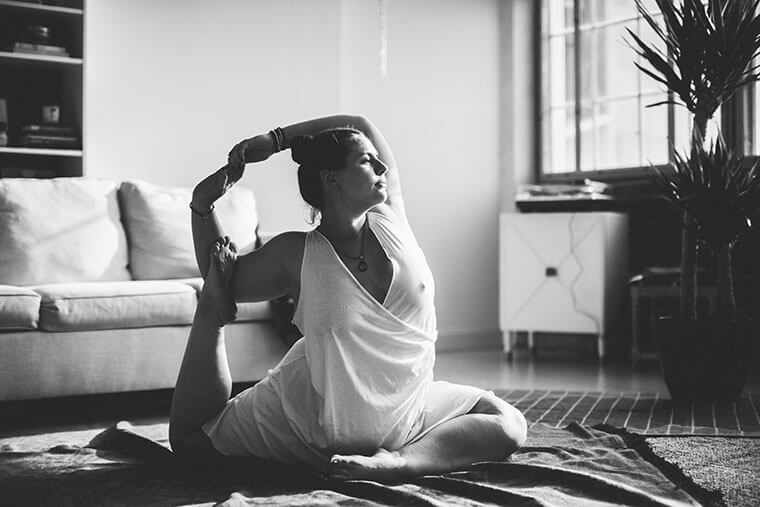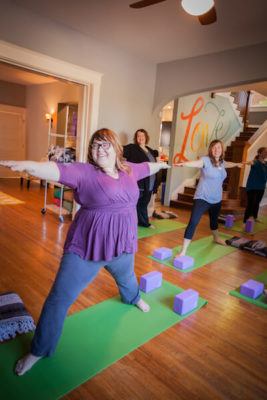The Plus Factor: and Why There’s a Yogi in Our Logo
Well+Good is your healthiest relationship, hooking you up with the best, most interesting things/people/leggings in wellness. And nothing gets at this concept better than the plus sign in our logo.
Inside this plus sign, which acts like a gallery window, we showcase the most exciting, transformative objects and ideas that add wellness to your life. This week, we’re focused on the incredibly inspiring body-positivity movement that’s taken hold of the yoga world, which we showcase here in The Plus Factor.
A few years ago, the term “yoga body” was mainly used by the mainstream media to describe someone like Jennifer Aniston or Gwyneth Paltrow—in other words, a unicorn woman with long limbs, toned-yet-lean muscles, and a negligible body fat percentage.
But today, that phrase’s narrow connotation feels as dated as The Rachel. Thanks to a group of activists committed to proving that every body is a yoga body, the practice is being adopted by a whole new wave of yogis who may have once felt left out of the conversation. And the entire industry is taking notice of this seismic shift toward inclusion, from teachers and studios to yoga apparel brands.
What is ‘body-positive’ yoga, anyway?
Although the body-positive yoga movement has been brewing for several years, it’s only recently entered the mass consciousness and mainstream media, courtesy of Instagram stars such as Jessamyn Stanley and Valerie Sagun (pictured below). These figureheads of strength and self-love captivate their hundreds of thousands of followers with a combination of flawlessly executed asanas and empowering captions—and they provide a refreshingly real contrast to what's been viewed as a parade of bird-like blondes that typically dominates the #yogaeverydamnday hashtag (not that there's anything wrong with their bodies, either).
View this post on InstagramA post shared by Jessamyn (@mynameisjessamyn) on
The term “body-positive” has a slightly different meaning for everyone, yet its core message is one of acceptance and belief in oneself—no matter how thin, flexible, or adept at handstands you may be.

{{post.sponsorText}}
“Modern media has perpetuated an untrue perception that only a certain type of person, with a particular body type, does and can practice yoga," says popular Los Angeles-based yoga teacher Brigitte Kouba, who has written extensively about her experience as a yogi with self-described "thick thighs, wide hips, and large breasts."
Kouba says, "You see these images everywhere, from yoga magazines to car insurance commercials. Yet we know, more and more, that this is completely untrue. Yoga can benefit individuals of all different ages, shapes, sizes, and abilities because it's not just a physical practice. When we quiet the mind, we can more deeply understand and appreciate the body."

Anna Guest-Jelley, founder of Curvy Yoga, prefers to use the term “body-affirming,” since, she says, it’s rare that anyone feels totally “positive” about his or her body 24/7. “Whatever you call it, it’s about being with the truth of your body in the moment and showing yourself as much kindness as you can muster, grace for when that doesn’t feel like much, and space for your relationship with yourself to ebb and flow,” she explains.
And unlike meditation or other forms of exercise, she says, “Yoga is the best way I know for bringing the work of body acceptance from the head, which is still an important part of the process, into the body where it can all be integrated.”
The industry reacts

As this increasingly diverse cohort of warrior-pose role models continues to steal the spotlight—and activist organizations like the Yoga & Body Image Coalition spread the self-love message through workshops, online campaigns, and books—many who once felt uncomfortable stepping onto the mat are now claiming yoga on their own terms. “When I first started practicing, I’d go into a class and the teacher and most of the people in the class were average-bodied,” recalls Dana Falsetti, a popular yoga teacher who became an icon for the body-positive revolution via her Instagram account, @nolatrees. “You can feel defeated just being in that situation. So seeing photos of someone who looks like you doing something you think you can’t do... that, in itself, can really be the spark that a lot of people need to give yoga a chance.”
It also helps that there are now entire classes and studios geared towards larger bodies (including Fat Yoga in Portland and Buddha Body Yoga in New York City, among others), while platforms such as Curvy Yoga and Body Positive Yoga train instructors on how to modify and cue classes for a wide range of body types.
Apparel companies are starting to court this growing contingent of yogis, with stylish brands such as K.Deer, Fractal9, and Lineage serving the plus-size market—and not a moment too soon, according to Falsetti. “Finding comfortable, well-fitting, cute yoga clothes for larger-bodied people had really been impossible until about a year ago,” she says. “It’s amazing to see clothes that are inclusive for all people.”
What's next for body-positive yoga?
If there’s a downside to the body-positive movement, says Falsetti, it’s that brands and personalities are starting to latch on to its messaging as a marketing tactic without truly embodying its ideals. “I personally feel that the term isn’t always being used in a particularly authentic way, but that’s also the direction that anything goes as it gets popular,” she muses.
But there’s no question that the benefits of this revolution far outshine any questionable bandwagon-hopping—and its lessons transcend weight and waistline measurements. As Stanley put it in a recent essay penned for Wanderlust: “Skinny people, people with chicken legs, thunder thighs, ‘cankles,’ large chests, zero chest, big booties, zero booty; people with non-traditional gender expressions; people with scars, freckles, birthmarks: These bodies need positivity too.”
“We all have different experiences, but at the end of the day, that particular struggle of understanding your worth and respecting yourself—that’s a common struggle among everybody"
Falsetti, who’s passionate about using her platform to raise eating disorder awareness, seconds this notion. “As I’ve become public with my challenges with body image, I’ve realized that almost everyone has a voice in their head [that criticizes] the way they eat or the way they look,” she says. “We all have different experiences, but at the end of the day, that particular struggle of understanding your worth and respecting yourself—that’s a common struggle among everybody.”
So perhaps the next frontier is broadening the self-love message to be about more than just body type—because, let’s face it, we’ve all felt pangs of insecurity and comparison in yoga class, whether we’re a size 2 or 22. After all, this practice isn't about achieving perfectly staged poses for Instagram. Rather, says Guest-Jelley, "it's that ability for each of us to show up as we are that reflects the spirit of yoga.”
Ready to start your own body-positive yoga journey? Kick it off with this 7-day self-love reset and read this advice on shutting down your inner mean girl. And here's what else we've featured in The Plus Factor.
Loading More Posts...